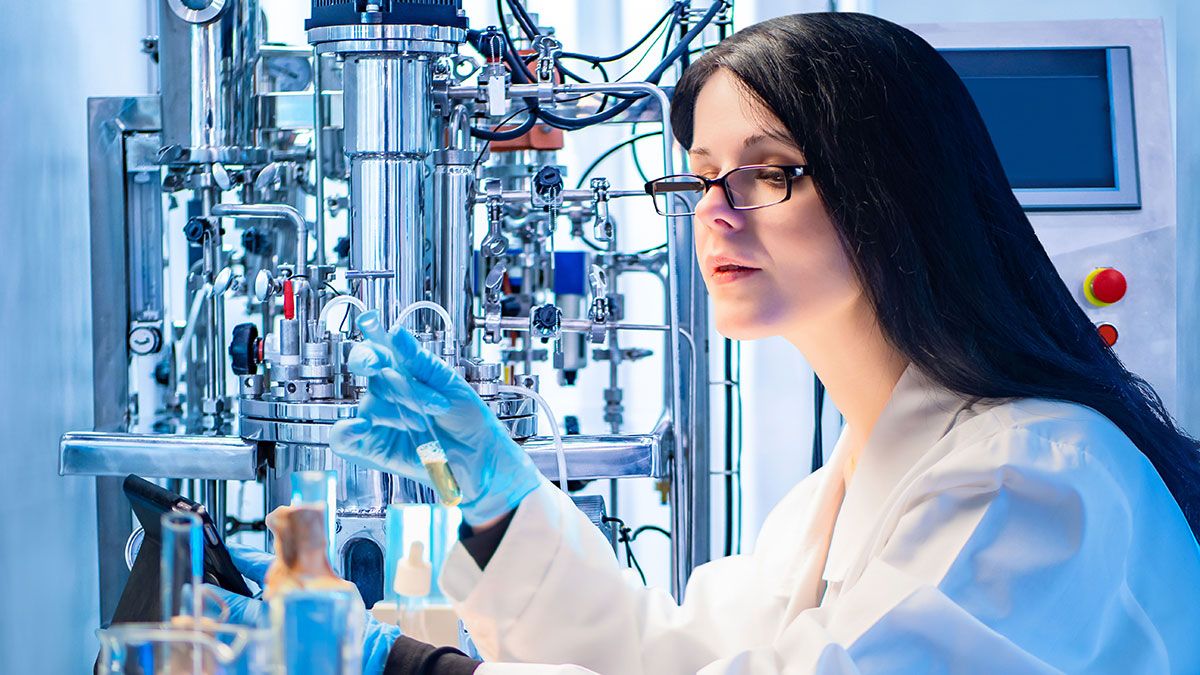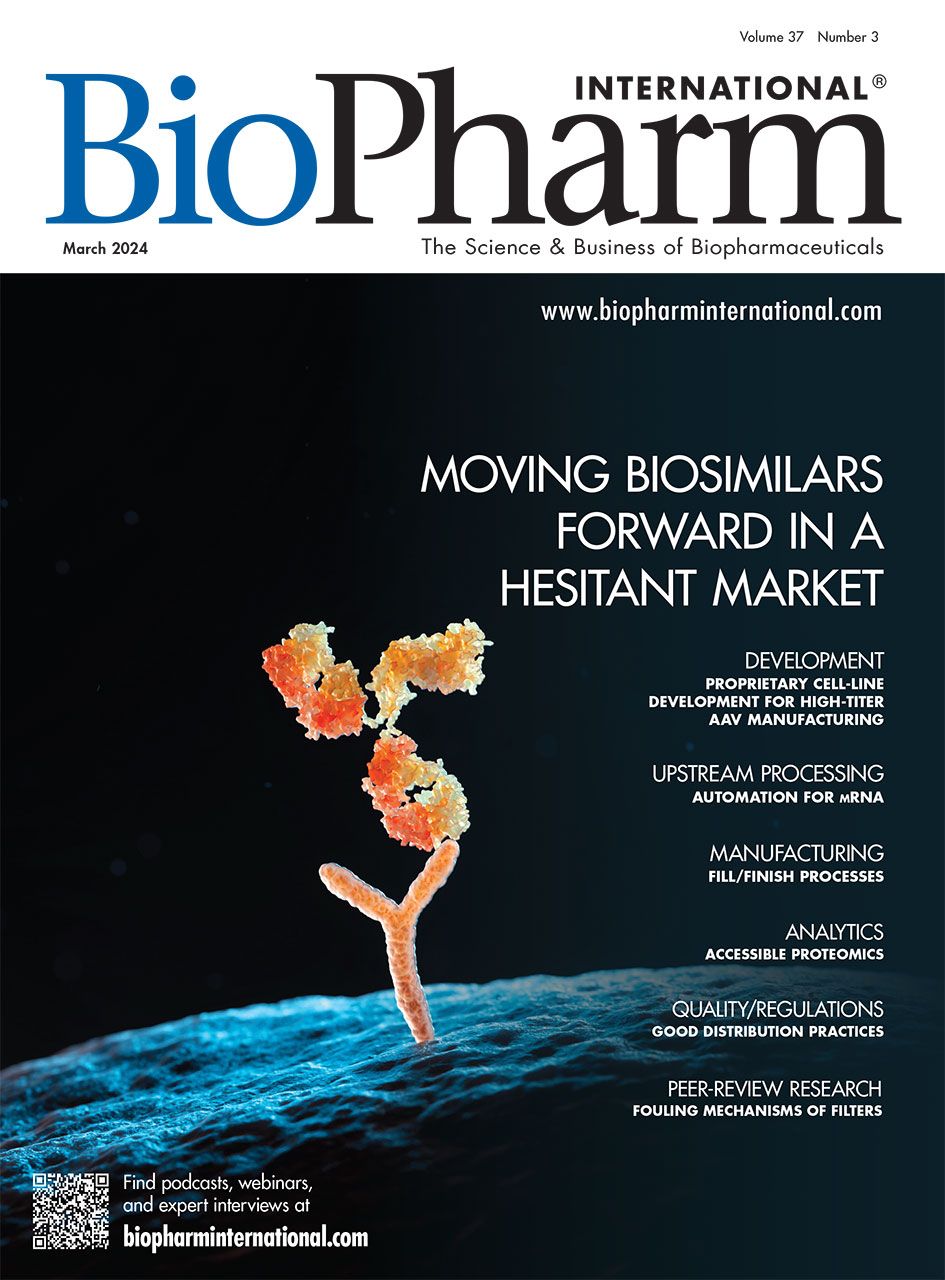The Making of mRNA
A tidal wave of questions floats the need for more upstream automation.
Laboratory assistant works next to the bioreactor. Concept - woman synthesizes a bio preparation. Vaccine development. Girl works as a biologist. Woman works as a pharmacologist. Scientific research | Image Credit: ©Grispb - stock.adobe.com

Sudden demand for large-scale manufacturing of messenger RNA (mRNA) drug substances during the COVID-19 pandemic has few parallels in the history of pharmaceuticals. Some might posit penicillin production during World War II as an analog, or perhaps early insulin availability. Pandemics and epidemics such as smallpox, typhus, cholera, influenza, HIV/AIDS, or the bubonic plague, all relied more on infection control for resolution than on manufacturing capacity. New therapeutic uses for mRNA are now ramping up good manufacturing practice (GMP) demand, especially for clinical trial supply. Moderna collaborated with CARsgen Therapeutics to combine an mRNA therapeutic cancer vaccine with a solid tumor chimeric antigen receptor (CAR)-T cell therapy, aiming to treat multiple cancers (1). Pfizer partnered with Beam therapeutics to co-develop mRNA and base editing approaches (2), while BioNTech and DualityBio have a partnership to develop differentiated antibody-drug conjugates, for solid tumors (3). In terms of upstream manufacturing for novel mRNA drug products, this technical complexity forms a tidal wave of question marks.
Costs decrease while complexity rises
A prominent paper (4) examined reducing complexity by evaluating what common process could be standardized through extrapolations of clinical trial complexity, based on four published papers Phase I-II dose ranging studies. While not the amounts of product required during the COVID-19 pandemic, clinical trial doses quickly mounted up in terms of both volume and also manufacturing challenges related to techniques pursued, but also formulation delivery requirements. The authors state, “from the four studies, the average mRNA usage was 5500 μg and for the 75 trials in 2021, 412 500 μg of RNA would need to be formulated, purified, sterile filtered, and fill-finished. At concentrations of 100 to 200 μg of mRNA per mL, this would amount to 2063 to 4125 mL of drug product” (4). As an interesting foray into possible future manufacturing, the authors went on to contrast traditional mRNA with a self-amplifying method. Often, this is cited as potentially a 100 to 1 decrease in required finished product due to higher potency performances, but this study chose a picturesque perspective, saying, “assuming the entire population consists of 7.7 billion people, and each person receives two doses, a total of 15.4 billion doses or 4.5 million L of the vaccine is required. In perspective, 4.5 million L would fill two Olympic-sized swimming pools (2500 m3), whereas saRNA [self-amplifying RNA] vaccines, which we assume are 100-fold more potent, would only require 0.02 Olympic-sized swimming pools. Assuming that production costs, which account for materials, RNA, and LNP [lipid nanoparticles] production, scale linearly, vaccinating the entire population with Pfizer/BioNTech’s mRNA vaccine would cost approximately 150 billion USD. In contrast, with saRNA, it would only cost approximately 1.5 billion USD” (4).
The making of mRNA
Commercial-scale mRNA is produced through chemical, recombinant, or enzyme-based methods. For chains under 100 nucleotides, the standard chemical technique “utilizes phosphoramidite chemistry and solid-phase support promoting chain elongation from the 3′ end to the 5′ end” (2). It is amenable to automation, as is recombinant production through host cells such as Escherichia coli (E. Coli), which has some cost advantages as it can utilize legacy protein manufacturing lines, already in GMP compliance. Enzymatic processes are newer to arrive and have tradeoffs still being worked through. A study conducted by the Duke Human Vaccine Institute explored creating standardized robust manufacturing processing steps, saying they confronted the lack of established quality standards by, in part, surveying vendor operations “through questionnaire and/or audit relating to the vendors’ quality systems and operations as they pertained to manufacturing and/or testing of the materials” (5). The study adopted the Weismann–Karikó method of production, the upstream process requiring three enzymatic steps of plasmid linearization, mRNA transcription, and DNA template digestion. In the starting out phase, fundamentals the authors emphasized were that “for optimal in vitro transcription yields, it is critical to start with high quality template DNA. Some key quality attributes that are required before use include the presence of only a single band of linearized DNA, a supercoiled ratio of at least 70%, and a sequencing-verified correct poly(A) tail length” (5). They also noted that “endotoxin control was the primary raw material risk due to its variability in raw material lots and the difficulty of its removal in subsequent downstream purification steps … reaction agitation, temperature, incubation time, and reactant concentrations were also carefully examined for each reaction step in order to yield a robust upstream platform process across multiple mRNA constructs” (5).
GMP-grade products
To help guarantee the safety, quality, and regulatory compliance of the final product, Dale Patterson, vice president and general manager, Thermo Fisher Scientific, says, “First, raw materials should be of high quality and meet established specifications. This includes the use of pharmaceutical-grade chemicals, enzymes, and reagents that comply with relevant pharmacopeial standards. Suppliers should provide appropriate documentation, including certificates of analysis, transmissible spongiform encephalopathy agents (TSE) and Bovine Spongiform Encephalopathy (BSE) statements, etc. to demonstrate compliance with GMP requirements.” Patterson also talks about transparency, traceability, and documentation being crucial for ensuring quality control and for meeting regulatory requirements.
Melanie Cerullo, chief quality and regulatory officer, ReciBioPharm agrees and points to FDA’s new guidance on the Advanced Manufacturing Technologies Designation Program. “This is a great program where sponsor companies who are using novel manufacturing technologies can request to be considered,” Cerullo says. “The benefits include early interactions with FDA to help navigate the challenges associated with CMC development of novel technologies … With this program, FDA is saying that they are here to help support innovation and want to interact with companies early on.”
Containing costs
Optimizing synthesis “involves customizing the synthesis parameters, such as nucleotide or amidite ratios, modifications, and purification methods, to enhance DNA or RNA stability, translational efficiency, and therapeutic efficacy,” says Patterson. He goes on to emphasize that “process scalability is crucial for personalized cancer treatments or rare diseases, where patient-specific DNA or RNA therapeutics may be required in small quantities. “Implementing flexible and modular manufacturing systems,” says Patterson, “such as bead-based solid phase mRNA synthesis or biosynthesis of oligonucleotides that can be easily scaled up or down to accommodate varying production volumes is essential. This ensures efficient and cost-effective manufacturing while maintaining product quality and regulatory compliance,” he avers.
Cerullo draws attention to infectious disease, where “you need to scale up the manufacturing process to very high levels as we saw with [COVID-19]. So, the challenge becomes how to make a lot of material most efficiently. We are currently working with [FDA] and MIT [the Massachusetts Institute of Technology] on a grant to develop a continuous mRNA-LNP manufacturing process to enable rapid scale up and manufacturing of large quantities of doses for this very reason.”
Patterson continues, “another strategy is to leverage automation and process optimization technologies. This includes the use of robotics, machine learning, and artificial intelligence to automate production tasks and improve process control. Automation can reduce labor costs and minimize the risk of human error, resulting in higher efficiency, consistency, and product quality.” One can refer to an exploration by FDA to pursue an mRNA potential “platform pathway” for mRNA in the regulatory space. The concept gets complicated whether one is dealing with saRNA or circular RNA (circRNA), as handling and manufacturing aspects vary significantly. As they also do in terms of quantities, potency profiles, or absorption, distribution, metabolism, and excretion (ADME) considerations, or when discussing a generalized vaccine versus personalized oncology vaccines, gene editing, CAR-T, antibodies, or protein replacement therapies.
However, Cerullo contends, “the most efficient way to make process improvements is to have good, standard workflows for process development and manufacturing, evaluate and apply learnings from each time you run the process (like a continuous improvement loop), and be mindful that some constructs will behave differently and need individualized solutions.”
For its part, Pfizer found end-to-end automation for in vitro transcription reactions increases process throughput of mRNA vaccines and therapeutics. Because of this, Pfizer is creating a spin-off team to further develop assays capable of automation. Karena Smith, senior associate scientist at Pfizer, said this “allows template-directed synthesis of mRNA molecule. Therefore, developing a method to understand how each component affects the process is incredibly valuable” (5). By using a high-performance liquid handler for automation, “Pfizer increased the reaction throughput eightfold whilst achieving a tenfold decrease in reaction scale.” Smith continued, saying, “the automated process saw less than a 10% difference in final concentration samples, and no differences in mRNA attributes when compared to a manual process.”
Better processes
Volumes are small compared to traditional bioprocessing, being on the order of less than 100 liters for commercial products (compared with 2000 liters for proteins), and according to Cerullo, while “most mRNA manufacturing platforms for the drug substance are aqueous based and don’t have organic solvent requirements … However, organic solvent is widely used for lipid nanoparticle formulation, so advances in new delivery technologies, which would eliminate the use of large volumes of organic solvent, would have a positive impact on reduction of waste. This is the part of the process that presents the most challenges from a waste and safety infrastructure perspective,” she concludes.
Patterson points again to process optimization. “By fine-tuning reaction conditions, such as temperature, pressure, and reaction time, it is possible to minimize the need for excessive solvent volumes. Employing innovative techniques, such as continuous flow processing or solid-phase synthesis, can also help limit solvent requirements.” Patterson goes on further to point out that the ““design and implementation of closed-loop systems and solvent recovery processes can further reduce solvent waste. These systems enable the capture, purification, and reuse of solvents, minimizing both environmental impact and production costs.” Patterson also states, “another alternative is to take a biochemical, rather than purely chemical approach to synthesizing oligonucleotides. The chemistries that are currently used to produce oligonucleotides using phosphoramidites require significant quantities of organic solvents. Instead, several groups have been researching the possibility of synthesizing oligonucleotides with various enzymes. Initial studies have shown there may be a possibility that at least some oligonucleotides could be synthesized with enzymes in aqueous, non-toxic solutions. This is an alternative oligonucleotide synthesis technology that certainly has promise in reducing solvent consumption if it can be put into practice.”
References
- CARsgen. CARsgen Collaborates with Moderna to Evaluate CT041 in Combination with an mRNA Cancer Vaccine. Press Release. Aug. 21, 2023.
- Pfizer. Pfizer and Beam Enter Exclusive Multi-Target Research Collaboration to Advance Novel In Vivo Base Editing Programs for a Range of Rare Diseases. Press Release. Jan. 10, 2022.
- BioNTech. BioNTech and DualityBio Form Global Strategic Partnership to Accelerate Development of Differentiated Antibody-Drug Conjugate Therapeutics for Solid Tumors, BioNTech. Press Release. April 3, 2023.
- Blakney, A.; Webb, C.; Bathula, N. Current Status and Future Perspectives on MRNA Drug Manufacturing. Mol Pharm. 2022 19(4). doi: 10.1021/acs.molpharmaceut.2c00010.
- Johnson, M.; Denny, T.; Sempowski, G.; Haynes, B. Development of mRNA Manufacturing for Vaccines and Therapeutics: mRNA Platform Requirements and Development of a Scalable Production Process to Support Early Phase Clinical Trials. April 2022, Translational Research.
- Smith, K. Presentation. Bio Process International US West, Feb. 27-March 2, 2023.
Editor’s note: This is an extended version of the article that appeared in the March 2024 print issue of BioPharm International®.
About the author
Chris Spivey is editorial director of BioPharm International®.
Article details
BioPharm International®
Vol 37, No. 3
March 2024
Pages: 16-17
Citation
When referring to this article, please cite it as Spivey, C. The Making of mRNA. BioPharm International 2024 37 (3).

Thermo Fisher Opens Advanced Therapies Collaboration Center in California
April 18th 2025The 6000-square-foot facility will provide cell therapy developers the support they need to transition to CGMP manufacturing, and an expanded footprint of the new center is expected to open in Philadelphia later in 2025.